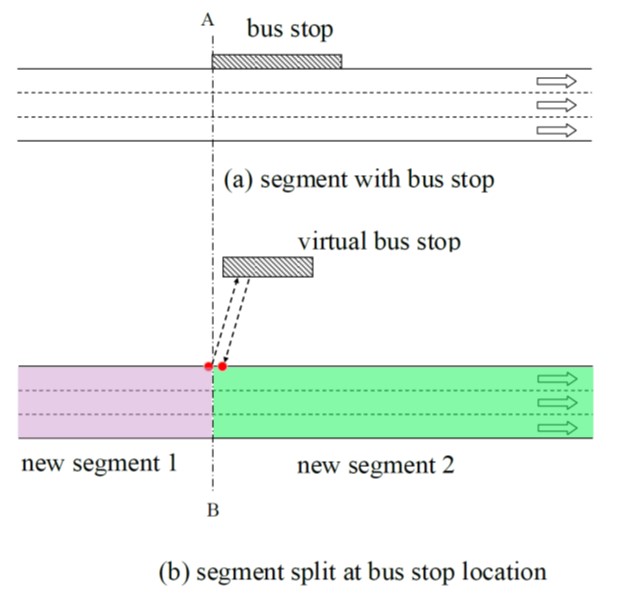-
Notifications
You must be signed in to change notification settings - Fork 29
Supply
The mid-term supply simulator is a mesoscopic traffic movement simulator that shares many common features with DynaMIT supply module (1, 2). The design motivation of mesoscopic supply simulator is to combine the high computational performance of macroscopic traffic flow models and the capability of microscopic simulation models in terms of replicating route choice behavior. Given the path of each traveler (the path in this context can be a sequence of road segments or public transport route segments depending on the type of network), the objective of the supply simulator is to estimate the actual movement trajectory of each vehicle.
The database tables describing the Supply network are described here. See also Conflux.
Simulation of heterogeneous vehicle types
The road network in SimMobilityMT is represented by a hierarchical structure composed of links, segments, lane groups and lanes. Segment is the basic processing unit of the supply simulator. Each segment represents a section of homogeneous roadway which is further divided into two traffic flow regions: the moving area and queuing area (see Figure 1 (a)). Vehicles in the moving area travel at some uniform positive speed determined by the traffic flow density of the area and a pre-defined macroscopic speed-density function (Figure. 1 (b)). Vehicles in the queuing area form a horizontal queue whenever the arrival rate of the traffic flow exceeds the outgoing (sending) capacity of the segment. As a result, two important supply parameters dominating the supply model are respectively the macroscopic speed density curve and segment sending capacities.

Fig. 1 Segment structure (a) and macroscopic speed density function (b)
In order to advance the position of each vehicle, two time intervals are defined: the advance interval and update interval. During each advance interval, the vehicle positions are updated according to their current status (moving or queuing) and macroscopic traffic flow parameters of the segments (density, capacity); then at the end of each update interval, the flow densities of the entire network are updated. (The capacity column in supply.segment table represents capacity per hour. If we have update interval as 5s and capacity as 800 vehicles per hour per lane, it means about 13.3 vehicles per min per lane and about 1 vehicle per update interval.)
Since the mid-term supply simulator needs to accommodate multiple car types with different physical characteristics, the passenger car unit (PCU) concept is adopted. The idea of PCU is to convert larger vehicle such as bus or truck into equivalent number of passenger cars. In mid-term supply, the PCU concept is used for consider the impact of large vehicles when computing flow density, queue length and capacity consumption of different vehicle types.
Virtual bus stop and bus simulation
Another major innovation in terms of supply is the simulation of bus movement. Because buses need to enter bus stops and interact with passengers, the simulation logic of bus is different from that of other vehicles. Two crucial aspects of bus simulation are bus stop modeling and bus movement logic. In mid-term system, the bus stop is modeled by adding a logic unit called virtual bus stop to the end of segments. Virtual bus stop is essentially a logic structure that encapsulates all the parameters of a bus stop. And in order to insert the virtual bus stop into the network at correct location, the original road segments are split into multiple new segments at the bus stop locations. The idea of virtual bus stop and re-segmentation of the network is illustrated by Figure. 2.

Figure 2: Illustration of different bus stop types and virtual bus stop concept, re-segmentation
The simulation of buses near bus stops is composed of four steps: lane selection, entering bus stop, boarding & alighting and re-joining traffic flow. The interaction between buses and the main flow traffic is also considered under this framework (such as queue spill-back from bus stop). Due to limited words restriction, detail discussions regarding the bus supply is not presented here.
Simulation of pedestrian/passenger
The pedestrian (passenger) movement is also simulated in mid-term supply model. Pedestrians always choose the shortest path between different stops and move at constant walking speed (3.6 20 km/h) which is configurable.
References:
-
Ben-Akiva, Moshe, et al. "Real time simulation of traffic demand-supply interactions within DynaMIT. "Transportation and network analysis: current trends. Springer US, 2002. 19-36.
-
Barceló, Jaume. Models, Traffic Models, Simulation, and Traffic Simulation. Springer New York, 2010.
-
Rajagopal, S. (1998). Development of Mesoscopic Traffic Simulator for DYNAMIT. Master. Thesis. Carnegie Mellon University, Pittsburgh, PA, USA, 1998.